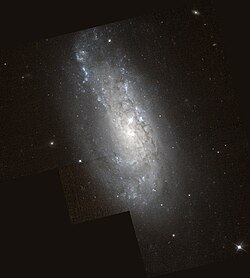| NGC 6207 | |
|---|---|
 NGC 6207 as seen through the Hubble Space Telescope | |
| Observation data (J2000 epoch) | |
| Constellation | Hercules |
| Right ascension | 16h 43m 03.7s |
| Declination | +36° 49′ 57″ |
| Redshift | 0.002842±0.000005 |
| Heliocentric radial velocity | 852±1 km/s |
| Galactocentric velocity | 1012±7 km/s |
| Apparent magnitude (V) | 11.7 +/- 0.4 |
| Absolute magnitude (V) | -19.62 +/- 0.48 |
| Characteristics | |
| Type | SA(s)c |
| Size | 34,000 light-years |
| Apparent size (V) | 3.00′ × 1.2′ |
| Other designations | |
| UGC 10521, MCG 6-37-7, ZWG 197.7, PGC 58827, KUG 1641+369, IRAS 16412+3655, KARA 766 | |
References: NASA/IPAC extragalactic datatbase, http://spider.seds.org/ | |
NGC 6207 is a spiral galaxy located in the constellation Hercules. It is designated as SA(s)c in the galaxy morphological classification scheme and was discovered by William Herschel on 16 May 1787. NGC 6207 is located at about 30 million light-years from Earth. In the sky, it is located near the globular cluster Messier 13. [1] [2] [3] [4]
Contents
